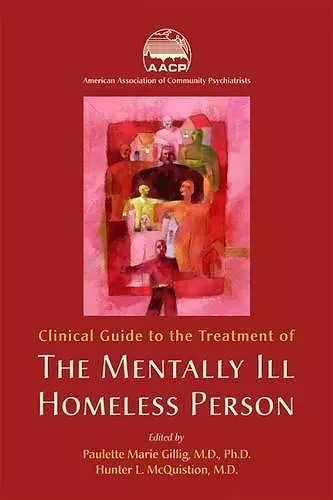Clinical Guide to the Treatment of the Mentally Ill Homeless Person
American Association of Community Psychiatrists author Paulette Marie Gillig editor Hunter L McQuistion editor
Format:Paperback
Publisher:American Psychiatric Association Publishing
Published:3rd Oct '06
Currently unavailable, our supplier has not provided us a restock date

In this book, Drs. Paulette Marie Gillig and Hunter L. McQuiston have provided an outstanding review of the most recent advances in the clinical treatment of the mentally ill homeless population of the United States. Pedro Ruiz, M.D., Professor and Vice Chair, Department of Psychiatry and Behavioral Sciences, The University of Texas Medical School at Houston, Houston, Texas
The book offersdiscussions that provide approaches to therapy and rehabilitation from the vantage point of treatment environments, from street to housing. Its real-world orientation offers a detailed, practical team approach to situations posed by families, homeless children, veterans, urban and rural populations, and others.
A case-based, clinical guide applicable to a variety of settings, this book offers evidence-based expert advice on the difficult challenges inherent in working with underserved homeless populations. The American Association of Community Psychiatrists' Clinical Guide to the Treatment of the Mentally Ill Homeless Person is a concise, practical work that gives busy clinicians the information they need; it not only is more up-to-date than existing publications, but also offers case- and site-based content that provides more hands-on, practical advice. Written by clinicians, for clinicians, it offers approaches to therapy and rehabilitation from the vantage point of the treatment environment, from street to housing and everything in between.
The book reflects approaches to the clinical care of homeless people refined over two decades, building not only on the work of academic research but more importantly on the firsthand experience of clinicians. Its organization by treatment setting or specific subpopulation allows readers quick access to the chapters most relevant to their work. The first five chapters follow a sequence of naturalistic settings—such as shelters and the work of Assertive Community Treatment Teams—that demonstrate a model of engagement, intensive care, and ongoing rehabilitation. Subsequent chapters define specific scenarios that depict patients at various points on the engagement-rehabilitation continuum. Each chapter contains a clinical case example; guides to differential diagnosis, treatment planning, and accessing entitlements; and a flow chart for rehabilitation, including opportunities for student/resident or community involvement. The book emphasizes:
• A real-world orientation that provides a nuts-and-bolts approach to such cases as families, homeless children, veterans—even individuals in rural settings.
• Cases that enable readers to follow the progress of individuals as they progress through the network of care.
• The importance of Assertive Community Treatment and "housing first" models of rehabilitation.
• Data supporting the importance of Critical Time Intervention, particularly with regard to homeless families.
• Examples of clinical interviewing techniques for engagement and treatment of challenging individuals who are being seen in community settings. These illustrated techniques can...
Gillig, McQuistion, and colleagues offer a valuable reference, especially for students and professionals who are beginning their work with homeless populations. Undoubtedly (in fact, it is my hope) Clinical Guide will be used by many community psychiatry residents, psychiatric nursing students, and mental health professionals who are working with the homeless populations but are new in the field.
* PsycCRITIQUISBN: 9781585622511
Dimensions: unknown
Weight: 286g
197 pages